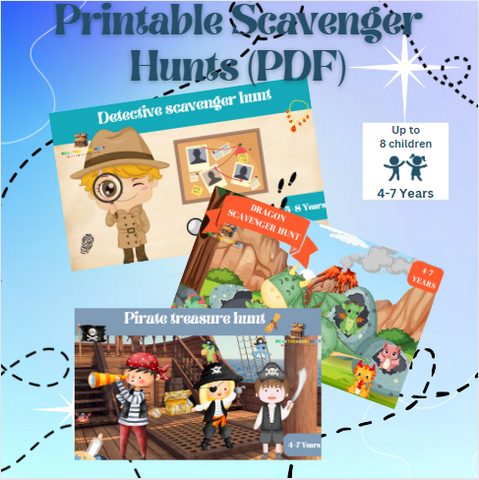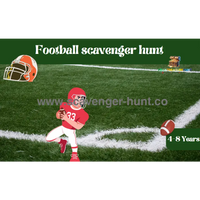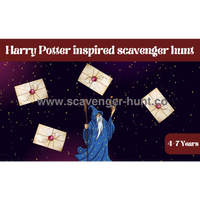🏫🎒Adventure Awaits: Crafting the Ultimate Scavenger Hunt for School Breaks
School vacations are a precious time for kids and families alike. It's a period filled with opportunities for fun, adventure, and exploration. However, keeping children entertained for weeks on end can be challenging. Enter the scavenger hunt—a perfect blend of adventure, puzzle-solving, and treasure-hunting that can turn an ordinary day into an extraordinary one. In this blog, we'll explore how to create an engaging and memorable scavenger hunt, packed with puzzles, treasures, and loads of fun. Whether you’re planning for a birthday party, a family gathering, or just a special day during the holidays, this guide will help you craft the ultimate scavenger hunt experience.
Planning Your Scavenger Hunt
1.1 Define the Objective
Before you dive into the nitty-gritty of planning a scavenger hunt, it's essential to define its objective. What do you hope to achieve with this event? Are you aiming for educational enrichment, where each clue or puzzle has a learning component? For instance, you might create clues that involve math problems or historical facts that children need to solve to progress.
Alternatively, your scavenger hunt might be purely for entertainment, designed to provide a fun and engaging activity without any educational elements. In this case, the focus would be on creative and amusing challenges that are sure to delight the participants.
You could also opt for a mix of both—where the scavenger hunt includes entertaining elements but also incorporates educational aspects. This approach not only keeps the participants engaged but also provides a subtle learning experience.
Clearly outlining your objective will help shape the design of the puzzles, the complexity of the challenges, and the overall structure of the scavenger hunt. It will also ensure that the final event aligns with your goals and meets the expectations of your participants.
1.2 Choose the Location
The location of your scavenger hunt is crucial as it sets the stage for the entire event. The choice of location will influence the type of clues and challenges you can create. Here’s a breakdown of popular locations:
1.2.1 Backyard: A backyard is a versatile and easily controllable location for a scavenger hunt. It allows you to incorporate various elements such as garden features, play structures, and even hidden nooks. It’s perfect for smaller groups and can be tailored to suit different age levels.
1.2.2 Local Park: Parks offer a larger space and natural elements that can be used creatively in your scavenger hunt. You can use trees, benches, and playground equipment as part of the clues. Be mindful of park regulations and the presence of other park-goers to ensure a smooth experience.
1.2.3 Home: An indoor scavenger hunt can be equally exciting. Utilize rooms, furniture, and household items to create clues and challenges. This option is ideal for inclement weather or if you prefer a more controlled environment.
1.2.4 Community Spaces: Consider using community centers, libraries, or other public spaces. These locations can provide unique settings and additional resources, but you will need to get permission and coordinate with the facility.
Choose a location that best fits your group size, age range, and the type of scavenger hunt you plan to organize. The location should enhance the experience, not hinder it.

1.3 Set the Date and Time
Selecting the right date and time is crucial for ensuring maximum participation and enjoyment. Here are some tips to help you decide:
1.3.1 Consider Participant Availability: Choose a date and time that aligns with the schedules of all participants. If it’s a group activity, coordinate with parents or guardians to find a suitable time that works for everyone involved.
1.3.2 Weather Conditions: For outdoor scavenger hunts, weather plays a significant role. Check the weather forecast and have a backup plan in case of rain or extreme heat. You might want to consider a rain date or have an indoor alternative prepared.
1.3.3 Duration: Decide on the duration of the scavenger hunt. Generally, a scavenger hunt lasts between 30 minutes to 2 hours. The duration should match the complexity of the hunt and the age of the participants. Younger children may benefit from a shorter, more straightforward hunt, while older kids might enjoy a more extended and challenging experience.
1.3.4 Time of Day: Plan for a time of day when participants will be most energetic and engaged. Avoid early mornings or late afternoons when energy levels might be lower. Midday or early afternoon often works well.
By carefully choosing the date and time, you can ensure a smooth and enjoyable scavenger hunt experience for everyone involved.
1.4 Gather Supplies
Proper preparation is key to a successful scavenger hunt. Here’s a checklist of supplies and materials you might need:
1.4.1 Clues and Puzzles: Create and print or write out all the clues and puzzles. Ensure they are clear, legible, and tailored to the difficulty level of the participants. If using physical clues, consider waterproofing them or placing them in protective containers.
1.4.2 Treasure Items: Gather the treasure items you plan to hide. These could be small toys, candies, or themed prizes. Ensure that the items are suitable for the age group and the theme of the scavenger hunt.
1.4.3 Puzzle Pieces: If your scavenger hunt includes jigsaw puzzles or other puzzle components, prepare these in advance. Make sure all pieces are accounted for and in good condition.
1.4.4 Special Equipment: Depending on your scavenger hunt design, you might need special equipment such as a map, magnifying glasses, or UV flashlights for hidden messages. Ensure you have all the necessary tools ready before the event.
1.4.5 Setup Materials: Collect items needed for setting up the scavenger hunt, such as tape, markers, or props related to your theme. Ensure you have a plan for organizing and hiding the clues.
Make a checklist of all the materials and supplies you need, and check them off as you prepare. Being well-organized will help the scavenger hunt run smoothly and keep everyone engaged and excited.


Designing Puzzles and Clues
2.1 Crafting Clues
Designing engaging and age-appropriate clues is a crucial step in creating a memorable scavenger hunt. Here’s how to craft clues that captivate and challenge participants:
2.1.1 Age Appropriateness: Tailor your clues to the age and skill level of the participants. For younger children, use simple language and straightforward instructions. Clues might involve basic shapes, colors, or simple riddles. For older kids, consider more complex puzzles that require critical thinking or problem-solving skills.
2.1.2 Types of Clues:
-
Riddles: Riddles are a classic choice for scavenger hunt clues. They can be fun and challenging, and they often require some creative thinking. Make sure the riddles are solvable and lead clearly to the next location or clue.
-
Word Games: Incorporate word games like crosswords or word searches that reveal the next clue when solved. This can add an educational twist to the scavenger hunt.
-
Physical Challenges: Incorporate physical challenges or tasks that need to be completed before finding the next clue. This could be something like a simple obstacle course or a task such as “find a hidden object” or “perform a certain action.”
2.1.3 Logical Flow: Ensure that each clue logically leads to the next step. The progression should be smooth, with each clue building on the previous one. Avoid creating dead ends or confusing jumps that might frustrate participants.
2.1.4 Presentation: How you present the clues can add to the excitement. Consider using creative methods such as hiding clues in small boxes, inside balloons, or even as part of a mini-game or activity.
2.2 Incorporating Puzzles
Adding puzzles to your scavenger hunt can make the experience more interactive and stimulating. Here are some types of puzzles to consider:
2.2.1 Jigsaw Puzzles: Create a custom jigsaw puzzle that reveals a clue or map when completed. This can be a fun way for participants to piece together the next step in the hunt. Ensure the puzzle is appropriately challenging for the age group.
2.2.2 Cryptograms: Use simple substitution ciphers or code-breaking puzzles where participants need to decode a message to find the next clue. This adds an element of mystery and can be particularly engaging for older children.
2.2.3 Math Problems: For a more educational twist, include math problems that, when solved, provide a clue or a hint. This works well for older kids and can be integrated into the hunt to reinforce learning in a fun way.
2.2.4 Riddles and Brain Teasers: Incorporate a variety of riddles and brain teasers that challenge participants to think creatively. Ensure they are solvable and contribute to the overall flow of the scavenger hunt.
2.2.5 Hidden Messages: Use invisible ink or hidden compartments to conceal parts of the clue. Participants can use black lights or other tools to reveal the hidden message, adding an element of discovery.
2.3 Creating a Theme
A well-chosen theme can transform a scavenger hunt into an immersive adventure. Here’s how to incorporate a theme into your scavenger hunt:
2.3.1 Selecting a Theme: Choose a theme that aligns with the interests of the participants. Popular themes include pirates, detectives, superheroes, space explorers, and historical eras like ancient Egypt or medieval times. The theme will guide the design of your clues and puzzles.
2.3.2 Themed Clues: Tailor your clues to fit the theme. For instance, if your theme is pirates, clues might involve treasure maps, pirate lingo, and references to famous pirate adventures. For a space-themed hunt, you might use references to planets, astronauts, and space missions.
2.3.3 Themed Decor: Enhance the atmosphere by decorating the location according to the theme. Use props, costumes, and decorations that reflect the chosen theme. This will create a more immersive experience and add to the excitement.
2.3.4 Themed Treasures: Choose treasure items that match the theme. For example, pirate-themed hunts could end with small toy treasures or pirate coins, while a superhero theme might feature action figures or themed accessories.
2.4 Hiding the Clues
The placement of clues is crucial to maintaining the right level of challenge and excitement. Here’s how to hide clues effectively:
2.4.1 Difficulty Level: Adjust the hiding spots based on the participants’ age and abilities. For younger children, keep clues in more visible or accessible locations. For older kids, make hiding spots more creative and challenging.
2.4.2 Safety and Accessibility: Ensure that hiding spots are safe and do not require participants to go into dangerous or difficult areas. Avoid spots that might be too high, too low, or involve risky movements.
2.4.3 Variety: Use a variety of hiding spots to keep the hunt interesting. You can hide clues under objects, inside containers, behind furniture, or even within other clues. Mixing it up will maintain the participants' engagement and curiosity.
2.4.4 Clue Transition: Place clues in a logical sequence so that each clue naturally leads to the next location. This will help maintain the flow of the scavenger hunt and ensure that participants don’t get stuck or confused.
2.4.5 Testing: Before the scavenger hunt begins, test the hiding spots to ensure that clues are well-hidden but not too difficult to find. Consider having someone who wasn’t involved in the planning try to find the clues to gauge their difficulty level.
By carefully designing your clues and puzzles, incorporating a compelling theme, and strategically hiding the clues, you’ll create a scavenger hunt that is both challenging and enjoyable, providing a memorable adventure for all participants.
Organizing the Treasure
3.1 Choosing the Treasure
Selecting the right treasure is essential for motivating participants and creating a satisfying conclusion to the scavenger hunt. Here’s how to choose and prepare the treasure:
3.1.1 Types of Treasure:
-
Small Toys: Consider small, age-appropriate toys that align with the scavenger hunt theme. For younger children, items like stickers, action figures, or small puzzles can be exciting. For older kids, you might opt for more sophisticated toys or gadgets.
-
Candies and Treats: Edible treasures are always a hit. Choose a variety of candies or snacks, but be mindful of any dietary restrictions or allergies among participants. Consider using themed treats that match the scavenger hunt’s theme for added excitement.
-
Special Prizes: For a grand finale, select a special prize that stands out. This could be a themed item related to the hunt, such as a pirate hat for a pirate-themed hunt or a space-themed book for an outer-space adventure.
-
Experience-Based Rewards: Sometimes, the best treasure isn’t something physical. Consider offering experience-based rewards, like a voucher for a fun activity or a special outing. These can be especially meaningful and memorable.
3.1.2 Motivation Factor: Ensure the treasure is motivating enough to encourage full participation. The excitement of finding a rewarding prize can drive participants to engage more enthusiastically with the clues and challenges. The value of the treasure should reflect the effort required to find it and the age of the participants.
3.1.3 Presentation: How you present the treasure can enhance its appeal. Use themed wrapping, decorative boxes, or treasure chests to make the final prize feel special. The presentation adds an element of surprise and excitement.
3.2 Distributing the Treasure
The distribution of the treasure is a key component in maintaining the challenge and enjoyment of the scavenger hunt. Here’s how to effectively distribute the treasure:
3.2.1 Final Prize: If your scavenger hunt involves a single grand prize, ensure that it is well-hidden and represents the culmination of the hunt. The final prize should be placed in a location that requires completing all the clues and challenges to reach.
3.2.2 Multiple Prizes: For hunts with multiple clues or stages, consider placing smaller treasures or tokens at different locations. These smaller prizes can serve as interim rewards and keep participants motivated as they progress through the hunt.
3.2.3 Clue-Based Distribution: In a more complex scavenger hunt, you might distribute parts of a larger prize or clues to the final treasure. Each clue could reveal a piece of the overall treasure, making the hunt more engaging and interactive.
3.2.4 Balancing Difficulty: The hiding spots for the treasure should balance challenge with accessibility. Ensure that the final prize or smaller treasures are challenging enough to find but not so difficult that they cause frustration. Test the hiding spots to verify that they are achievable for the intended age group.
3.2.5 Thematic Consistency: Make sure that the distribution of the treasure aligns with the theme of the scavenger hunt. For example, in a pirate-themed hunt, treasure might be hidden in a pirate chest or buried in a sandbox. In a detective-themed hunt, the final prize might be hidden in a “crime scene” area.
3.3 Ensuring Safety
The safety of participants is paramount when organizing a scavenger hunt. Here’s how to ensure that the treasure and its hiding spots are safe:
3.3.1 Safe Locations: Avoid hiding treasures in locations that could pose physical hazards, such as near sharp objects, in high places, or in areas with potential for injury. Ensure that all hiding spots are accessible and safe for participants to reach.
3.3.2 Age-Appropriate Spots: Make sure that the hiding spots are appropriate for the age group. For younger children, avoid places that require climbing or crawling. For older kids, ensure that the challenge level is matched to their physical abilities.
3.3.3 Clear Boundaries: Set clear boundaries for the scavenger hunt area to prevent participants from wandering into unsafe or off-limits locations. Ensure that all participants understand the boundaries and the rules for the hunt.
3.3.4 Supervision: Provide adequate supervision to ensure that all participants are safe and follow the rules. Have adults or responsible older kids present to assist if needed and to ensure that the hunt proceeds smoothly.
3.3.5 Regular Checks: Before the scavenger hunt begins, perform a thorough check of all hiding spots to ensure they are safe and secure. Make any necessary adjustments to avoid potential hazards.
By carefully choosing, distributing, and ensuring the safety of the treasure, you’ll create a rewarding and enjoyable conclusion to your scavenger hunt, leaving participants thrilled with their adventure and their prizes.


Running the Scavenger Hunt
4.1 Explaining the Rules
Effective communication of the rules and objectives is crucial for a successful scavenger hunt. Here’s how to set the stage for a smooth and enjoyable event:
4.1.1 Clear Instructions: Begin by gathering all participants and clearly explaining the rules of the scavenger hunt. Make sure everyone understands how the game works, what they need to do, and the overall objective.
4.1.2 Objectives and Goals: Outline the main objectives of the hunt. Clarify whether the goal is to find all clues, solve a specific puzzle, or reach the final treasure. Ensure that everyone knows what they are aiming for.
4.1.3 Boundaries: Define the boundaries of the scavenger hunt area. Make it clear where participants are allowed to search and where they should avoid. This helps in preventing participants from wandering into unsafe or off-limits areas.
4.1.4 Rules of Engagement: Explain any specific rules, such as working in teams or individually, how to handle found clues, and any behavior expectations. Let participants know if there are any restrictions, like not running or not disturbing other people’s property.
4.1.5 Safety Guidelines: Remind participants of safety guidelines. Emphasize the importance of staying within the designated area and being cautious while searching. Ensure they know who to approach if they need help.
4.2 Providing Guidance
Support and guidance during the scavenger hunt can help maintain enthusiasm and ensure a positive experience for all participants:
4.2.1 Be Available: Make sure you or a designated helper is readily available to offer hints or answer questions. Participants might get stuck or need clarification on clues, and having someone to assist can keep the hunt moving smoothly.
4.2.2 Offering Hints: If participants are struggling, offer subtle hints rather than giving away the answers. You can provide small nudges in the right direction to help them overcome obstacles without making it too easy.
4.2.3 Balancing Support: Find the right balance between providing guidance and allowing participants to figure things out on their own. Too much assistance can reduce the challenge, while too little can lead to frustration.
4.4.4 Encouragement: Provide encouragement and positive reinforcement throughout the scavenger hunt. Celebrate small victories and progress to keep participants motivated and engaged.
4.2.5 Adjusting Difficulty: Be prepared to adjust the difficulty of the clues or challenges if necessary. If you notice that participants are consistently getting stuck or are too easily solving the clues, make real-time adjustments to maintain the right level of challenge.
4.3 Monitoring Progress
Keeping track of the scavenger hunt’s progress is essential for ensuring everything runs smoothly and remains enjoyable:
4.3.1 Progress Checks: Regularly check on the progress of the scavenger hunt. This helps you gauge how well participants are doing and if they are on track to complete the hunt within the allotted time.
4.3.2 Adjustments: Be ready to make adjustments if you notice any issues, such as clues being too difficult or participants taking too long. Minor changes can help keep the hunt flowing and prevent it from becoming frustrating.
4.3.3 Time Management: Keep an eye on the time to ensure the scavenger hunt stays on schedule. If the event is running long, consider simplifying the remaining clues or speeding up the process to ensure it concludes in a timely manner.
4.3.4 Observing Interactions: Observe how participants are interacting with each other. Ensure that the scavenger hunt is enjoyable for everyone and that there are no conflicts or issues between participants.
4.3.5 Safety Checks: Continuously monitor the environment to ensure that it remains safe for all participants. Address any safety concerns promptly to avoid accidents or injuries.
4.4 Celebrating Success
Celebrating the end of the scavenger hunt is an important way to acknowledge participants’ efforts and create a memorable experience:
4.4.1 Final Rewards: Present the final treasure or rewards in a celebratory manner. This could involve a small ceremony where you highlight the efforts of the participants and distribute the prizes.
4.4.2 Acknowledging Efforts: Take the time to recognize and appreciate everyone’s efforts. Highlight individual or team achievements and thank everyone for their participation. This can be done through verbal praise or small tokens of appreciation.
4.4.3 Celebratory Activities: Consider incorporating additional celebratory activities, such as a group photo, a small party, or a special treat. This adds a festive element to the end of the scavenger hunt and makes it a memorable event.
4.4.4 Feedback Collection: Gather feedback from participants about their experience. This can be done informally during the celebration or through a quick survey. Understanding what went well and what could be improved helps in planning future scavenger hunts.
4.4.5 Sharing the Experience: Share highlights of the scavenger hunt with participants, such as photos or stories from the event. This helps reinforce the positive experience and provides a keepsake for everyone involved.
By clearly explaining the rules, providing thoughtful guidance, monitoring progress, and celebrating success, you’ll ensure that your scavenger hunt is not only fun and engaging but also a well-organized and memorable event for all participants.
Post-Hunt Activities and Reflection
5.1 Reviewing the Event
After the scavenger hunt has concluded, taking time to review the event is essential for understanding its success and areas for improvement. Here’s how to effectively gather feedback and reflect on the experience:
5.1.1 Collecting Feedback: Engage with participants, parents, or other organizers to gather their impressions of the scavenger hunt. This can be done through informal conversations, feedback forms, or surveys. Ask specific questions about what they enjoyed, what challenges they faced, and any suggestions for improvement.
5.1.2 Analyzing Responses: Review the feedback to identify common themes or issues. Look for patterns in the responses to understand which aspects of the scavenger hunt were particularly successful and which areas need adjustments.
5.1.3 Evaluating Objectives: Assess whether the scavenger hunt met its initial objectives. Reflect on whether the event was educational, entertaining, or both, and how well it engaged the participants.
5.1.4 Identifying Strengths and Weaknesses: Take note of what worked well and what didn’t. This might include aspects such as clue difficulty, treasure appeal, or organization. Understanding these elements will help you make informed improvements for future events.
5.1.5 Incorporating Feedback: Use the feedback to make actionable changes. If participants found certain clues too challenging or enjoyed specific types of puzzles, incorporate these insights into your planning process.
5.2 Documenting the Experience
Capturing the scavenger hunt through photos or videos provides lasting memories and can enhance the post-event experience for participants. Here’s how to document and share the event:
5.2.1 Taking Photos and Videos: During the scavenger hunt, take candid photos and videos of participants in action. Capture moments of excitement, teamwork, and problem-solving. Ensure you have permission to take and share images, especially if there are children involved.
5.2.2 Creating a Highlights Reel: Compile a selection of the best photos and videos into a highlights reel or slideshow. This can be a fun way to recap the event and share the excitement with participants.
5.2.3 Sharing with Participants: Share the documented content with participants after the event. This could be done through email, social media, or a shared digital album. Providing access to these keepsakes allows participants to relive the fun and excitement of the scavenger hunt.
5.2.4 Making a Memory Book: For a more tangible keepsake, consider creating a memory book or scrapbook with photos and notes from the scavenger hunt. This can be a wonderful way for participants to remember the event and cherish their experience.
5.2.5 Reflecting on Documentation: Review the photos and videos to see how participants interacted with the clues and each other. This can provide additional insights into the event’s dynamics and areas for future improvement.
5.3 Planning for the Future
Use the insights gained from the event and feedback to enhance future scavenger hunts. Here’s how to plan and refine your approach:
5.3.1 Implementing Improvements: Based on feedback and observations, make necessary adjustments to the scavenger hunt format, clues, or treasure. Address any identified weaknesses and build on the successful aspects.
5.3.2 Introducing New Elements: Keep future scavenger hunts fresh and exciting by introducing new themes, puzzles, or activities. Experiment with different formats or technologies to add variety and enhance the experience.
5.3.3 Scheduling Regular Events: Consider making scavenger hunts a regular activity. Regularly scheduled events can keep participants engaged and looking forward to future hunts. It also provides more opportunities to test out new ideas and gather ongoing feedback.
5.3.4 Engaging Participants: Involve participants in the planning process for future hunts. Their input can provide valuable perspectives and help tailor the scavenger hunts to their preferences and interests.
5.3.5 Reviewing Trends and Best Practices: Stay informed about current trends and best practices in scavenger hunt design. This can include new types of puzzles, innovative themes, or changes in technology that could enhance your scavenger hunts.
By thoroughly reviewing the event, documenting the experience, and planning for the future, you can continually improve your scavenger hunts and ensure they remain enjoyable and engaging for all participants.

Final Thoughts
A well-executed scavenger hunt has the remarkable ability to transform an ordinary day into an extraordinary adventure. It blends the excitement of puzzles, the thrill of finding hidden treasures, and the joy of a shared experience into a memorable event that captivates participants of all ages. When thoughtfully designed and meticulously planned, a scavenger hunt becomes more than just a game; it becomes a cherished memory and a highlight of the school vacation.
Creating a Memorable Experience:
-
Engagement: By tailoring clues and challenges to the age and interests of the participants, you ensure that everyone remains engaged and invested in the hunt. The right mix of difficulty and creativity keeps the experience enjoyable and stimulating.
-
Teamwork: Scavenger hunts foster teamwork and collaboration, encouraging participants to work together, solve problems, and celebrate successes. This aspect of the hunt not only makes the event more interactive but also strengthens relationships and builds camaraderie.
-
Adventure: The sense of adventure and exploration adds an exciting element to the scavenger hunt. Whether it’s discovering hidden clues or finding the final treasure, the journey itself becomes a thrilling exploration filled with anticipation and discovery.
Planning for Success:
-
Attention to Detail: From designing engaging puzzles and choosing the perfect treasure to ensuring safety and providing guidance, every detail matters. A well-thought-out plan ensures that the scavenger hunt runs smoothly and is enjoyable for everyone involved.
-
Feedback and Improvement: Gathering feedback and reflecting on the event help refine and enhance future scavenger hunts. By understanding what worked well and what could be improved, you can continuously elevate the experience and keep participants excited for more.
-
Creativity: Embrace creativity in every aspect of the scavenger hunt. Themed clues, imaginative puzzles, and innovative hiding spots add a unique touch that makes the event stand out. Creativity turns a simple game into an unforgettable adventure.
Ready for Adventure:
So, gather your clues, hide your treasures, and prepare for an adventure that promises to captivate and delight. Whether you’re hosting a scavenger hunt for kids during school vacation or planning a fun activity for friends and family, the effort you put into organizing it will be rewarded with laughter, excitement, and unforgettable moments.
With thoughtful planning and a dash of creativity, your scavenger hunt will not only entertain but also create lasting memories, becoming a highlight of the season. Here’s to a successful scavenger hunt filled with fun, challenge, and adventure—happy hunting!
Scavenger Hunt During The School Vacations FAQ
1. How long should a scavenger hunt last?
The duration of a scavenger hunt can vary based on the age of the participants and the complexity of the clues. Typically, a scavenger hunt lasts between 30 minutes to 2 hours. For younger children, keep it shorter to maintain their interest.
2. What are some good themes for a scavenger hunt?
Popular themes include pirates, superheroes, detectives, space adventures, and historical explorations. Choose a theme that resonates with the interests of the participants to make the hunt more engaging.
3. How can I make the scavenger hunt more challenging for older kids?
Incorporate complex puzzles, riddles, or code-breaking elements. You can also make the clues more cryptic or require participants to solve multiple clues to find the final treasure.
4. What should I do if participants get stuck on a clue?
Be prepared to offer hints or clues to help participants progress. Make sure the hints guide them towards the solution without giving it away completely. Keeping a balance is key to maintaining their interest and excitement.
5. Can a scavenger hunt be done indoors?
Absolutely! Indoor scavenger hunts can be just as fun and engaging as outdoor ones. Use creative clues and puzzles that fit within the indoor environment, and make sure the hiding spots are safe and accessible.
Discover our Complete Scavenger Hunts Collection.


HOW TO PLAN A TREASURE HUNT FOR KIDS









































